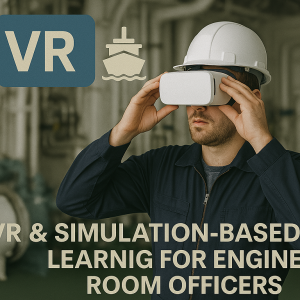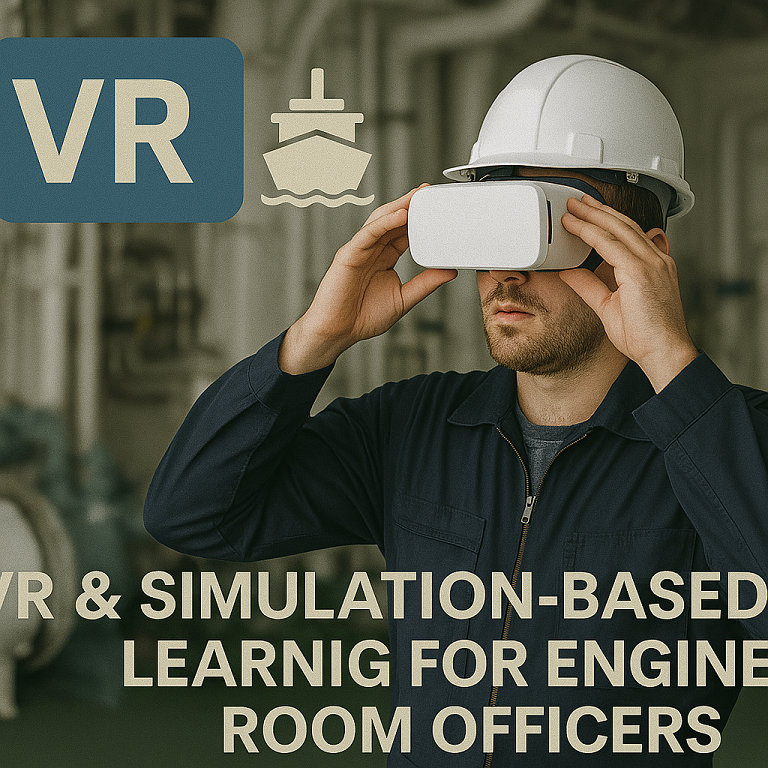
Discover how VR and simulation-based learning are transforming training for engine room officers. Learn about real-world applications, STCW compliance, and the future of maritime engine room education.
What if you could troubleshoot a fuel system failure, respond to a machinery fire, or perform an emergency shutdown—all without setting foot in an actual engine room?
In today’s digital maritime era, Virtual Reality (VR) and simulation-based learning have become powerful tools for training engine room officers. These immersive technologies are not just enhancing safety—they’re reshaping the very foundation of maritime engineering education.
Whether you’re a maritime student, cadet, ship engineer, shipping company, or training institute, this article will give you a comprehensive look into how simulation-based technologies are modernizing engine room training while staying aligned with STCW standards.
–
What Is Simulation-Based Learning for Engine Room Officers?
Simulation-based learning replicates real engine room operations using advanced software or VR. Trainees interact with digital controls, practice emergencies, and develop critical decision-making skills. VR headsets create immersive 360° engine room environments for realistic training. Simulation-based learning refers to training that replicates real-life engine room scenarios using advanced software or virtual environments. These simulations allow learners to:
-
Interact with digital control panels and machinery systems
-
Practice emergency protocols
-
Understand cause-effect relationships of system failures
-
Develop decision-making and problem-solving skills
When paired with VR headsets, this training becomes fully immersive—placing cadets in a realistic, 360° digital version of the ship’s engine room.
📌 Keyword Focus: “VR for engine room officers” and “simulation-based maritime training” are increasingly searched by maritime academies, STCW training centers, and marine engineers.
–
Why VR & Simulation Training Matters in Engine Room Education
Traditional training faces challenges like limited access to real engine rooms and high costs. VR and simulations provide standardized, risk-free training while reducing expenses. Studies show human error causes 75% of marine accidents, making immersive training essential.
Traditional Challenges:
-
Limited access to operational engine rooms
-
High costs of physical engine room simulators
-
Inconsistent training experiences across locations
-
Safety risks during real-life drills
VR & Simulations Solve These By:
-
Offering standardized, repeatable training
-
Allowing trainees to fail safely and learn from mistakes
-
Reducing operational costs
-
Supporting remote learning for global seafarers
⚠️ Fact: According to the International Maritime Organization (IMO), human error contributes to over 75% of marine accidents—much of it tied to poor training and response under pressure.
–
Key Concepts: Components of Simulation-Based Engine Room Training
Full Mission Simulators replicate engine room systems, including alarms and fault diagnosis. VR training offers hands-on practice with haptic feedback, while SCADA simulations teach automation. AI-driven analytics track performance for personalized coaching.
1. Engine Room Full Mission Simulators (ERFMS)
- Replicates main and auxiliary systems: diesel generators, boilers, pumps, compressors, etc.
- Integrated with alarms, fault diagnosis, emergency handling, and performance tracking
- Examples: Kongsberg K-Sim Engine, Transas ERS 5000
2. VR-Based Hands-On Training
- Learners navigate the 3D engine room
- Identify machinery parts, open valves, simulate fuel leaks, etc.
- Includes voice commands, haptic feedback, and eye tracking
3. SCADA & PLC Simulations
- Simulate programmable logic controllers and supervisory control systems
- Train officers in automation and system integration
4. Performance Analytics with AI
- Real-time feedback on response times, decision accuracy, and safety compliance
- Useful for certification assessments and personalized coaching
–
Real-World Use Cases & Applications
Simulations train officers in emergencies like engine fires and blackouts. Routine operations, such as fuel transfer and valve alignment, are also practiced. Case studies show VR training boosts exam pass rates by over 30% while cutting classroom time.
✅ Emergency Scenarios
- Engine room fire response
- Sudden blackout and generator changeover
- Cooling system failure under full load
- Emergency bilge system activation
✅ Routine Operations
- Lube oil circulation and purification
- Fuel bunkering and transfer
- Valve alignment and pump priming
- Pre-departure engine checks
✅ Troubleshooting & Fault Diagnosis
- Identify sensor failures
- React to out-of-limit temperatures/pressures
- Analyze system flowcharts and control loops
🚢 Case Study: One European maritime academy reduced classroom time by 40% and improved exam pass rates by 32% after implementing a hybrid VR + ERFMS program.
–
Benefits of Simulation-Based Learning for Engine Officers
Immersive training improves retention and safety compliance. Standardized modules ensure STCW alignment, while remote access supports continuous learning. Multi-user simulations enhance teamwork, and cost savings come from reduced fuel and machinery use.
| Feature | Impact |
|---|---|
| Immersive Practice | Replicates the stress and complexity of real ship operations |
| Standardized Curriculum | Ensures global STCW compliance and assessment consistency |
| 24/7 Accessibility | Enables continuous learning—even from home or ship |
| Enhanced Team Training | Multi-user simulations develop communication and teamwork skills |
| Cost-Effective Scaling | Reduces reliance on fuel, machinery wear, and live drills |
| Safety-First Learning | Eliminates real-world risk while improving emergency preparedness |
📊 Stat: Studies show trainees using simulation retain over 80% of learned skills, compared to 20–30% from textbooks and videos.
–
Latest Trends & Future Outlook
Cloud-based platforms enable global training access, while AI tailors learning paths. Gamification increases engagement, and metaverse integration fosters collaborative drills. Digital twin technology mirrors real engine rooms, ensuring company-specific training. By 2030, hybrid VR and simulation programs will dominate maritime education.
| Trend | Implication for Engine Room Training |
|---|---|
| Cloud-Based Simulation Platforms | Enables global access to certified training modules |
| Gamified Skill Assessments | Boosts engagement and knowledge retention among cadets |
| AI-Coached Training Programs | Personalized learning paths based on user performance |
| Metaverse Integration for Team Drills | Connects students and instructors in shared virtual engine environments |
| Digital Twin Technology | Mirrors real engine room configurations for company-specific training |
🧭 Forecast: By 2030, nearly all maritime academies and shipping companies will use hybrid training programs combining VR, AI, and simulation platforms.
–
FAQs: People Also Ask
Is VR training compliant with STCW for engine officers?
Yes, many VR and simulation-based tools are designed to align with STCW Code Part A and IMO model courses, particularly for engine resource management and operational proficiency.
Can engine room training be conducted fully online?
While some modules can be completed virtually, certification typically requires hands-on assessments under supervision—either using simulators or approved VR platforms.
Do shipping companies use simulation training onboard?
Yes. Some vessels are equipped with compact simulators or VR kits for refresher training during voyages, especially for Emergency Response Teams (ERTs) and engineers.
Are simulation platforms expensive?
Costs vary. High-end full mission simulators are expensive, but VR headsets + cloud-based software are far more affordable and scalable.
Conclusion: Powering the Future of Marine Engineering Training
As ships become smarter and systems more automated, engine room officers must be more competent than ever. VR and simulation-based learning offer the ideal blend of immersion, accuracy, and safety, preparing future engineers to face real-world challenges with confidence.
⚙️ Call to Action: Whether you’re a cadet, officer, or academy director—invest in simulation-based tools today to train for the engine room of tomorrow.

